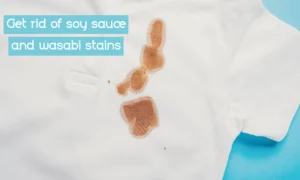
Sushi is a wonderful delight that everyone likes to enjoy once in a while. However, if you are not proficient with chopsticks, you are most likely going to end up with a bunch of soy sauce and wasabi sauce all over your clothing. Even though some would say it is totally worth it, stained clothing is definitely unsightly. Do not panic if anything like this happens. Those stains can be easily removed at home using everyday household products that you probably have in your kitchen cupboard.
Fish sauce, wasabi, and soy sauce all have different stain compositions. Fish sauce, for example, creates a protein-based stain. Wasabi’s green colour makes dye-based stains, while the brown soy sauce leaves tannin-based marks on fabrics. Treating all these different stains requires slightly different approaches, such as the protein-based fish sauce stains should never be treated with hot water. This will cause the cooking of the protein and make the stain extremely hard to remove or even permanent.
As with most stains, all those should be treated as soon as possible in order to succeed in complete removal.
Before you begin, you should always check the care label of the fabric before attempting any cleaning methods. Another thing to keep in mind is that you should never rub the stain since that will push the stain deeper into the fibres of the garment and make them harder to get rid of. When you choose the product you will be using, always test it in a small inconspicuous area to make sure it is not causing any damage or discolouration.
While most products are gentle enough to be suitable for a variety of fabrics, it is best to know the specific recommendation for the particular type of garment you are treating to ensure proper removal of the stain without causing damage. If the stain is dry or old, you may need to repeat the cleaning steps several times in order to succeed.
Cleaning sushi, soy sauce, and wasabi stains from clothing
-
Remove solids – Scrape any solids like wasabi or roe, using a blunt knife or the edge of a credit card. Be careful not to rub the substance into the fabric – that will make it more difficult to remove. If the stain is liquid, blot the moisture away with a paper towel or a clean dry cloth.
-
Flush the stain – Flush the stain by holding it inside out under a running sink faucet. It is best to use cold water, especially if trying to remove fish sauce stains, since hot water, as we already mentioned, will cook the protein and cause it to set. The force of the water will push the stain out of the fabric fibres.
-
Pre-treat – Pretreat the stain with an enzyme-based heavy-duty laundry detergent like Tide or Persil. Those are strong enough to dissolve the substances causing the stain and make them easier to remove. Apply the product to the stained area, rub it in with your fingers, and let it sit for about 10 minutes. If the stain persists, try an oxygen bleach soak.
-
Prepare the solution and soak – Fill a sink or a tub with cool water and add oxygen bleach according to packaging instructions. Submerge the garment and let it sit for at least 30 minutes. Check the stained area and if the stain remains, continue soaking the fabric for another few hours, or overnight. This treatment is suitable for coloured and synthetic fabrics. However, you should not use it for silk, wool, or leather garments. After the soak, wash the garments as usual.
How to remove sushi, soy sauce, and wasabi stains from carpets and upholstery
When treating stains on carpets and upholstery, you can use the same method. Just make sure you are not oversaturating the fabric of the upholstery since trapped moisture in furniture cushions can cause mould and mildew growth.
-
Remove solids – Scrape off any solids using a dull knife or a plastic scraper.
-
Mix a solution – Depending on the severity of the stain you can choose one of the following cleaning solutions. Always test on a small hidden area to prevent damage.
-
Mix 1 teaspoon of dishwashing liquid and 2 cups of lukewarm water. Apply with a clean white cloth or a soft-bristled brush to apply to the stained area. Rinse with a clean cloth dipped in plain water.
-
Mix a solution of cool water and oxygen bleach following package instructions. Allow it to sit for at least 30 minutes, then blot away the moisture.
-
For older stains, dip a sponge in a mixture of 1 teaspoon of non-sudsing household ammonia and 1 cup of water. Always test, especially on darker fabrics.
-
Blot away the moisture and let the area air dry. When completely dry, use your vacuum cleaner to restore and lift the fibres of the fabric.